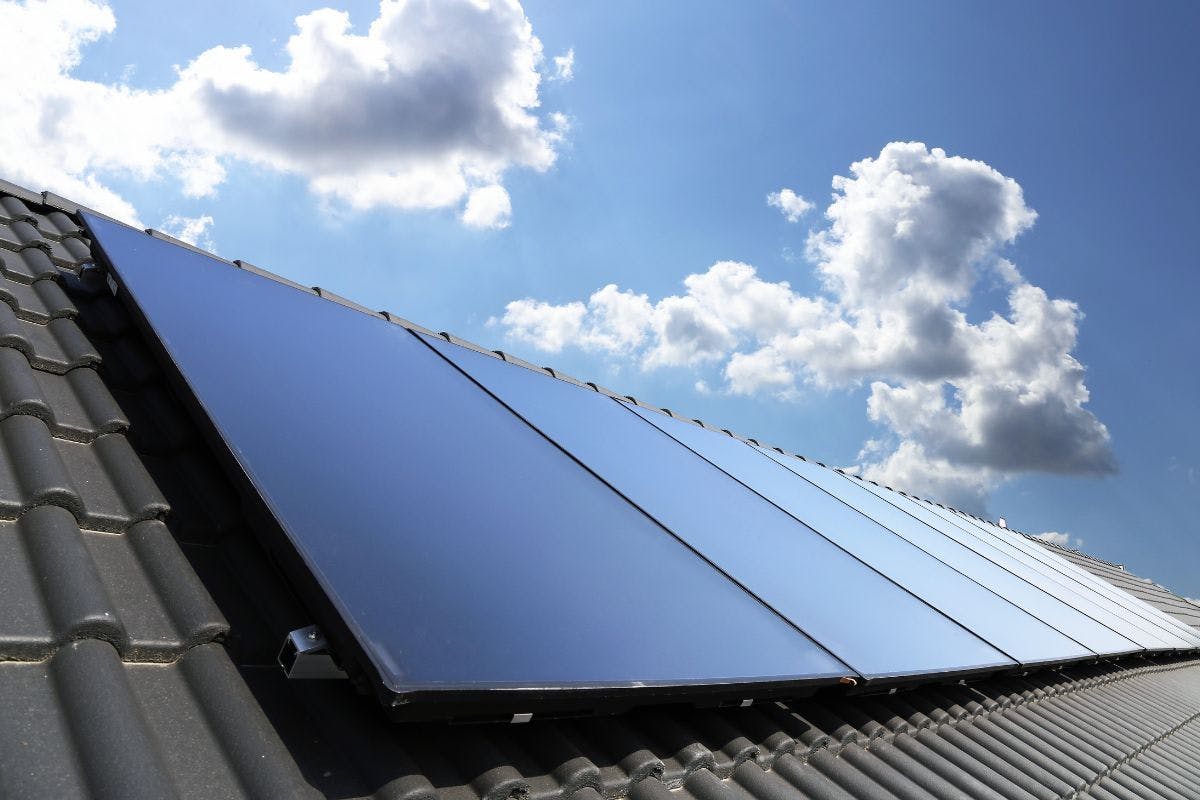How Local Solar Permitting Impacts the Cost of Your Solar Panels
Actualizado

Autor
Andrew Giermak
Solar and Electrification Writer and Editor

Editor
Andrew Blok
Electrification and Solar Writer and Editor

Installing home solar panels involves construction, electrical work, and safety measures. So, before turning your solar electricity on, new owners must get their system inspected and permitted. In most cities and states, your local government and your area’s utility company will require the proper permitting. Unfortunately, this can make the solar installation process longer and more expensive.
Teaming up with the right solar power company makes this process easier, as does knowing more about the permitting process.
See how much you can save by going solar with Palmetto
What Is Local Solar Permitting?
The local solar permitting and interconnection process requires approval by at least two entities before your solar panel system can be installed.
1. Local building authority: Often referred to as your authority having jurisdiction or "AHJ," a governmental agency reviews and approves all required building, electrical, and solar PV permits.
2. Electric utility company: The local electric utility needs to review and approve your application for interconnection to the distribution grid.
In both cases, the solar permit application process requires detailed documentation on your approach, including location plan, site plan, roof specifications, wiring schematics, and system components, among others.
Local solar permitting ensures your home’s solar array meets the required electrical and structural requirements in your area. The permitting process takes four basic steps.
- In most cases, the solar installation company submits the applications for permits and interconnection. Permit requirements vary by location, but typically contain information about the system certified by a professional engineer.
- Once all permits and approvals have been secured, the contractors are permitted to install your solar panel system and related work.
- After the installation, your local permitting authorities will likely require a final site inspection.
- Once your solar system passes the inspection, you apply for "permission to operate” or PTO from your utility company. Once granted, you can turn your system on.
Keep in mind solar permitting requirements differ from one city, state, or utility company to another. Some jurisdictions have multiple overlapping authorities tasked with approving single projects. This can complicate matters for solar panel installation companies as they navigate permitting applications across different localities.
Despite these challenges, some regions have streamlined permitting practices to make it easier and less expensive to install solar panel systems, including:
- Allowing online submissions for solar permit applications
- Making permitting application information publicly available
- Capping how long officials can take to process permit applications
- Reducing municipality-specific permit requirements
What Is the Solar Permit Process?
Solar permitting can be the most time-consuming step in the solar installation process. Your solar company should be able to help you complete all necessary documentation and application forms to begin the permit filing process.
Step 1: Apply for interconnection
Once you have the engineered plans and have completed the requisite electric utility applications and forms, you can apply for interconnection with your utility company. Interconnection and approval allow you to connect your solar energy system to the electric grid.
After you or your solar provider submit the application, the utility company will review the design to ensure it meets safety requirements.
Typically, the electric utility company will confirm the specs of your plan adhere to IEEE 1547 grid codes and applicable equipment requirements, paying specific attention to the system size and offset thresholds set for solar net metering.
The essential design specification they look for include:
- The location of your utility meter
- The proposed solar panel array, including the layout of your roof and any obstacles
- The number of solar panels and inverters used in your project, including the manufacturer and installation process
- The capacity rating for your proposed power inverter and panels
Step 2: Complete application forms for your AHJ
Authorities having jurisdictions include any person, organization, or office that monitors all manner of solar panel installation to confirm everything is up to code and adheres to various regulations. In most cases, this will be your local building department, though there may be additional AHJs depending on your location.
The application forms are typically 10-15 pages long, and include the following:
- Solar panel wiring diagrams
- Fire safety rating
- Site map
- Labels and placard placement map for PV systems
- Certifications for the panels and the mounting hardware
It can be very time-consuming to compile all required materials, which is why it’s often better for your solar provider or solar panel installer to take care of the permitting details for you.
Step 3: Apply for building permits
The required permits will vary by location and may include a building permit for solar panel installation, an electrical permit, and/or a PV or solar permit. Your local AHJs will review your application to ensure the project design complies with local building codes and safety requirements.
For example, the building department will confirm your roof can handle the extra weight of the solar energy system. While most newer homes have roofs strong enough to handle the additional weight, older homes may have dated or damaged roofs that cannot safely support a solar array. In some cases, your home may require additional work, such as a re-roof or an electrical upgrade, before you can secure permits and proceed with solar panel installation.
It takes time to process your building permit, and a rejected permit application may increase the timeline to installation. It can also increase your potential costs if the local building official determines the home needs a reroof or electrical upgrade to support the solar panels.
See how much you can save by going solar with Palmetto
Step 4: Secure approvals
After submitting your applications for permits, the AHJs and the utility company will review your applications and provide an approval or rejection. If they find any issues that require adjusting, they will decline the application and provide you with feedback to help you make the necessary revisions and re-submit for approval.
Once permits have been granted and the interconnection application approved, your solar company can begin the installation process.
Step 5: Inspection
After installation, you need to schedule a final inspection. Inspections are required to ensure your system was installed consistent with product specs and all applicable electrical, building, and fire codes and regulations in your area. While some jurisdictions may call for an inspection during the installation, all jurisdictions require a final inspection before you power on your system.
Step 6: Apply for permission to operate or PTO
Once the building inspector approves your system, you can apply for permission to operate (PTO) with your utility company. In most cases, a utility technician may visit your home to ensure your solar energy system meets electrical safety and metering guidelines. They can also install a new bi-directional energy meter capable of tracking both the energy you consume and the energy you produce, so the electric utility can credit your account accordingly.
Thorough inspections and proper permitting are necessary to guarantee your solar power system operates as it should for years to come.
Reasons Local Solar Permitting Increases Installation Costs
The local solar permitting process can increase the cost of the rooftop solar installation process. Part of the reason is there are a lot of AHJs to keep track of, and each can have its own process, requirements, and timelines. For example, Palmetto is licensed with thousands of AHJs all across the country.
While it’s an important step to ensure the safety and longevity of your solar power system, it’s helpful to understand the impact this has on your total cost of going solar.
Research and engineering costs
Depending on the jurisdiction, the installer may need to research the code, customize installation drawings, and apply for zoning approval before installing. In addition to being costly, this stage can be time-consuming, as the permit needs to be reviewed by a professional engineer before approval.
In-person submission requirements
Some cities require you to drop off the permit application in person. If you live far from the local permitting offices, dropping the permit packages in person or enlisting solar permit services will cost you more fuel, resources, and time.
Application and permit fees
Different jurisdictions charge varying permit fees to account for various expenses. Unfortunately, the solar installer has no control over these charges, and they often can’t predict them during the planning and design stage.
Variation in building requirements
In addition to the state or national code requirements, local jurisdictions sometimes have other conditions you must meet before you can use your solar panel system, including:
- Large fire barriers
- Labeling
- Extra disconnects to turn off the system
- Excessive roof penetrations
How the Solar Industry Can Streamline the Solar Permitting Process
While it’s important to ensure electrical and construction work is done correctly, new policies and regulations can slow the process and increase solar energy installation costs.
This has also created opportunities for solar companies and the industry to develop process improvements. While individual companies cannot override the local laws and regulations governing the installation, they can take steps to streamline the solar permitting process.
As part of the quest to simplify the permitting process, the U.S. National Renewable Energy Laboratory and the U.S. Department of Energy launched the Solar Automated Permit Processing (SolarAPP+). This free web-based platform makes it easy for the local governments and solar installers to safely expedite the solar review and installation process.
Credit: nrel.gov
How the Solar Automated Permit Processing could change the game
SolarAPP+ provides solar permit specialists and solar panel installers across the country with a standardized permitting process for residential installations. As more people switch to solar energy, permitting officials can become overwhelmed by the applications, causing unnecessary delays.
The Solar Automated Permit Process reviews solar project applications for building code compliance and automatically approves those that meet the required specifications. The tool's methodology is based on the International Solar Energy Provisions. In addition, jurisdictions can incorporate the tool into their existing licensing systems to enhance safety and code compliance.
Key benefits of using Solar Automated Permit Processing
- Automated permitting: SolarAPP+ provides a flexible web-based permitting tool for residential solar systems at no extra cost to local governments.
- Safety verification: The tool evaluates all applications for safety and code compliance before approval.
- Reduces installation timeframe: Since the tool standardizes the instant permitting process, permits can be approved the same day. As a result, the tool saves time and resources for the AHJs, solar companies, and customers.
- Room for future expansion: While SolarAPP+ currently focuses on residential solar, it aims to incorporate energy storage and work in other market segments in the future.
Local Solar Permitting and the Cost of Solar
The solar permitting process is more than walking down to city hall and filling some forms. It requires you to prove your project will adhere to local, state, and federal building standards before you install a solar energy system.
There may be unforeseen costs or delays, including backlogs in your local permitting office, or your home needing additional work before you can secure permits and proceed with the installation.
This is why it’s best to work with an experienced solar energy company. Solar companies like Palmetto have the knowledge and expertise to guide you through the permitting and interconnection steps. We pride ourselves in helping homeowners remove the guesswork in the installation process by providing end-to-end solutions that save you time and money.
If you’re ready to start enjoying the benefits of solar energy, you can get started today with our free solar savings calculator.
See what solar can do for you:
Frequently Asked Questions
How long does it take to get a solar permit?
The timing will depend on the state and the city where you live, but 2-6 weeks is a good rule of thumb.
How can I get the best solar battery for my system?
A reputable solar company should work with you to get the best solar battery backup as part of the optimal system design for your home, savings, and energy needs.
What happens if my permit is denied?
If your solar system permit is denied, the permitting office will provide reasons for the denial. Your solar company or installer will then make the necessary revisions to the plans or documentation, then resubmit the application.



